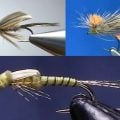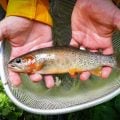How to Tie Landon Mayer’s Mini-Leech
Producer: Tim Flagler
This somewhat different looking fly is Landon Mayer’s Mini-Leech. As many of you know, I’m a sucker for any pattern that includes pine squirrel, and this one most certainly does. It also happens to be incredibly easy to tie and an absolute fish-catcher.
I’m going to start with a Fulling Mill Czech Nymph hook in size 14. Get the hook firmly secured in the jaws of your tying vise.
For thread, I’ve loaded a bobbin with a spool of black UTC 70 Denier. Start your thread on the hook shank leaving an eye-length space behind the eye and take a few wraps rearward before snipping or breaking off the tag.
Medium-sized brown Holo tinsel is used to add a little shimmer and color to the pattern, a 10” length will make numerous flies. Although not essential, an angled tie-in end will help keep things smooth. Secure the tinsel to the hook shank and take touching thread wraps rearward, binding the material well down into the bend. Then make smooth touching wraps forward with your tying thread until it hangs at about the hook point. Get hold of the tinsel and begin making slightly overlapping wraps with it, up the hook shank. When you reach your tying thread, use it to secure the material then snip the excess off close.
Zonked, brown pine squirrel is used for the body of the fly. I’m pretty thrifty with this stuff, so the method here results in no waste. With the fur angled back, strip a small amount free from the hide to create a short, leathery tab. Give your bobbin a good clockwise spin to add strength and bite to your tying thread. Use the thread to secure the bare leather directly on top of the hook shank above the point. Continue taking thread wraps forward, making sure the pine squirrel is bound down really well. Then take wraps rearward to the start of the fur. On this size hook, I like the tail to be only about an inch or so in length, the hide part that is. It’ll be longer, of course, with the fur swept back.
The thorax and head of the fly are formed using black ostrich herl. Strip a single, long herl free and hold it stem-side up. First snip the curly butt end off then strip the little flues from both sides until you’re left with bare stem. Trim the bare stem so there’s about 1/8” showing before the flues start. With the stem side of the herl pointing up, lay it against the near side of the hook and take thread wraps to firmly anchor it to the shank. Get hold of the herl, and begin making wraps with it, the stem should lead the way. This allows each successive wrap to lay on top of the prior one, without trapping any of the delicate flues. Continue taking wraps with the herl all the way up to your tying thread, just behind the hook eye.
When you reach your thread, use it to firmly anchor the herl. You can then snip the excess off close with the very tips of your tying scissors. Do a 4 or 5 turn whip finish, seat the knot well and snip or cut your tying thread free.
To add a little bit of shine to the head of the fly and to make sure the thread wraps won’t come unraveled, I reach for the Sally Hansen Hard as Nails. Just the smallest drop is all that’s needed.
This, folks, is a pattern you simply have to try in order to see how good it is. Absolutely try tying them in different color combinations, I’m pretty sure you’ll find they all work.
How to Tie Lance Egan’s Red Dart
How to Tie Matt Grajewski's Yard Sale











